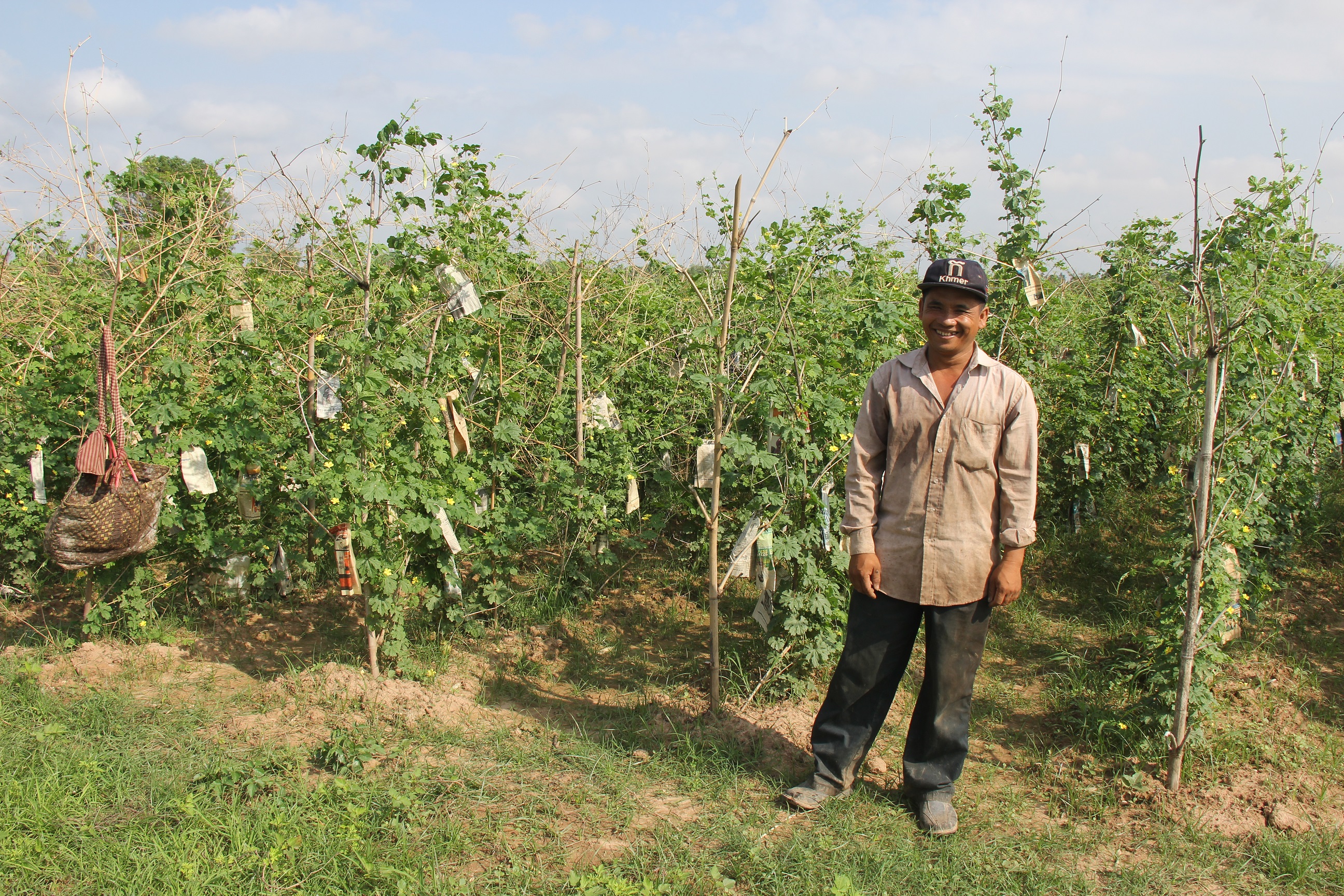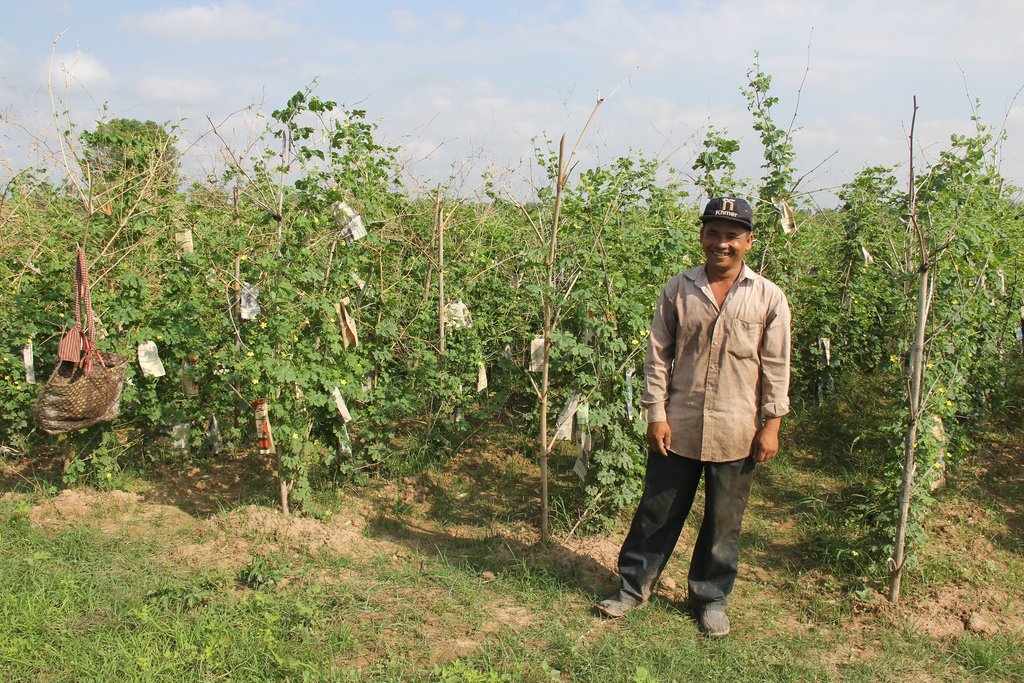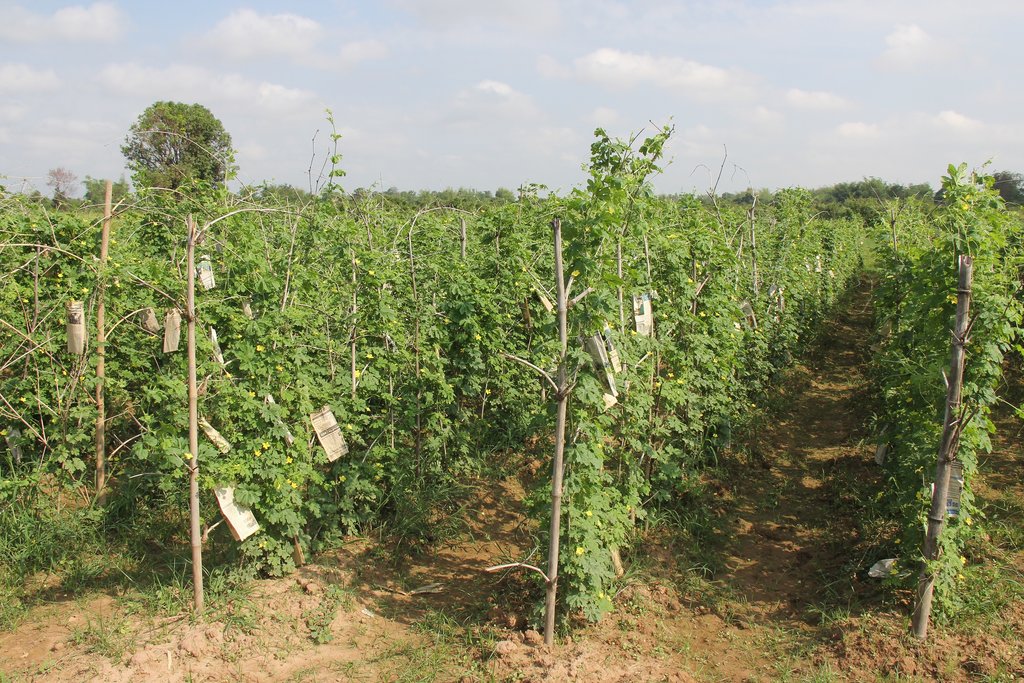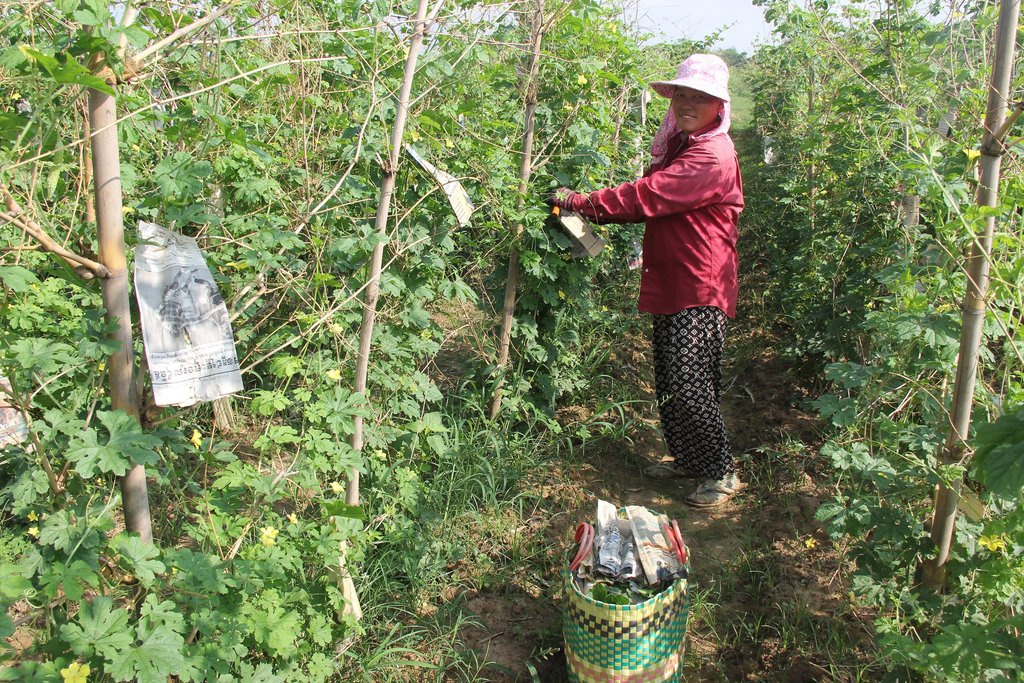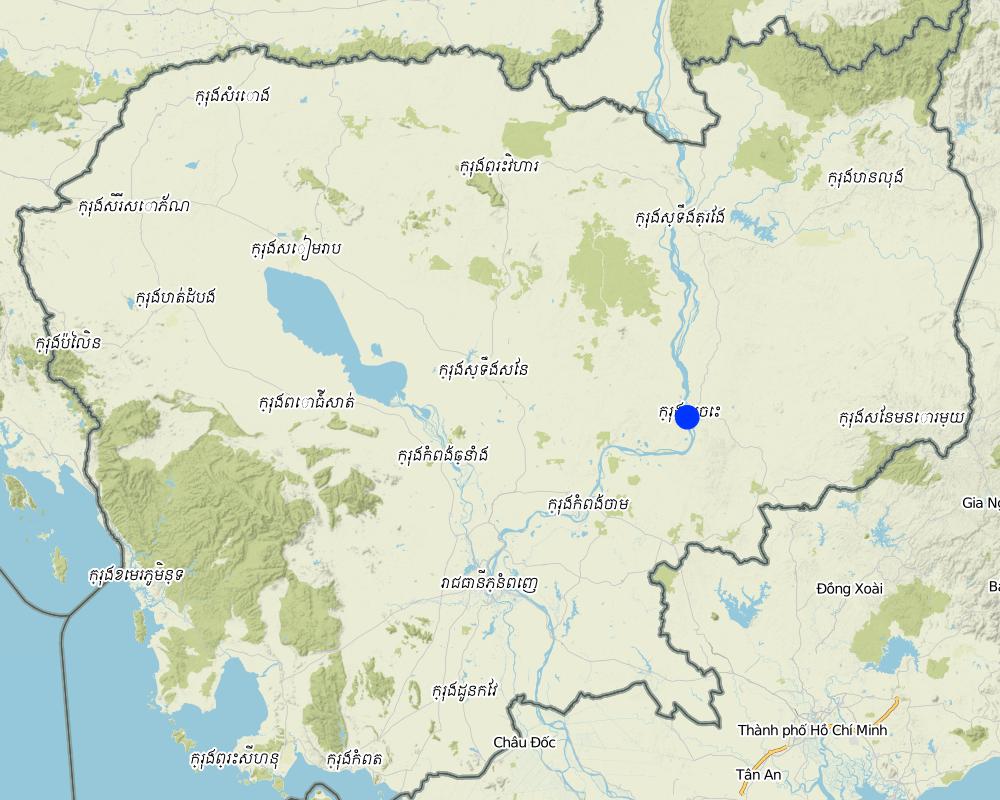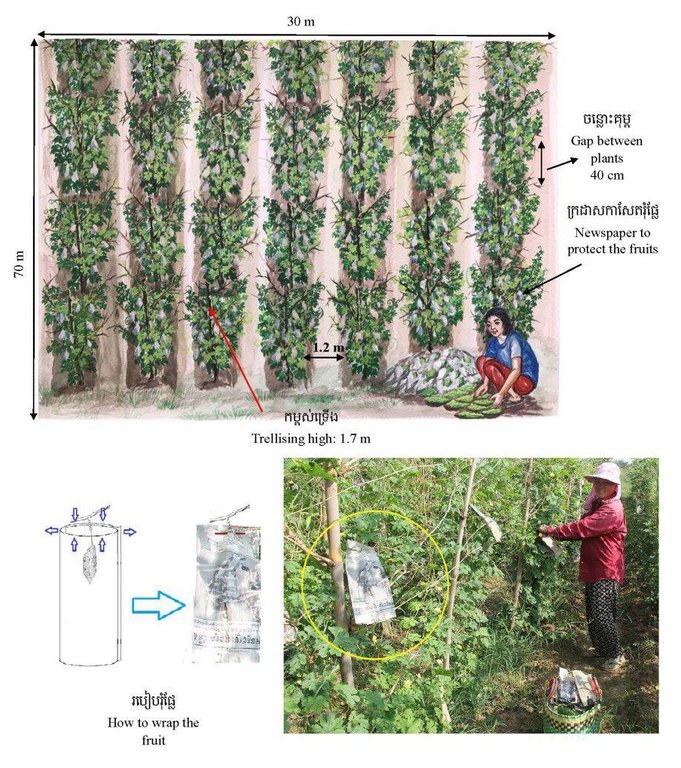ការការពារផ្លែម្រះដោយប្រើក្រដាសកាសែតចាស់ៗមករុំស្រោបផ្លែ [Cambodia]
- Creation:
- Update:
- Compiler: vann vun
- Editors: Be Gechkim, Sok Pheak, Sophea Tim, Navin Chea
- Reviewers: Ursula Gaemperli, SO Than, Nicole Harari, Cornelia Hett
ការដាំម្រះ
technologies_2101 - Cambodia
View sections
Expand all Collapse all1. General information
1.2 Contact details of resource persons and institutions involved in the assessment and documentation of the Technology
Key resource person(s)
ភ្នាក់ងារផ្សព្វផ្សាយ ឃុំសោប:
សុភ័ក្រ សុង
(+855) 97 942 33 88
មិនមានអ៊ីម៉ែល
សាលាឃុំសោប
ភូមិសោបលើ ឃុំសោប ស្រុកព្រែកប្រសព្វ ខេត្តក្រចេះ
Cambodia
អនុប្រធានមជ្ឈមណ្ឌលសិក្សាស្រាវជ្រាវកសិកម្ម និងបរិស្ថាននៃសាកលវិទ្យាល័យភូមិន្ទកសិកម្ម:
សុភា ទឹម
(+855) 12 291 592
stim3993@gmail.com / sopheatim2012@yahoo.com
មជ្ឈមណ្ឌលសិក្សាស្រាវជ្រាវកសិកម្ម និងបរិស្ថាននៃសាកលវិទ្យាល័យភូមិន្ទកសិកម្ម
ភូមិខ្វា សង្កាត់ដង្កោ ខ័ណ្ដដង្កោ រាជធានីភ្នំពេញ
Cambodia
ប្រធានការិយាល័យកសិកម្មស្រុកសំបូរ:
land user:
ចាន់ណាក់ ហ៊ួន
(+855) 90 80 824
មិនមានអ៊ីម៉ែល
កសិករ
ភូមិព្រែករកា ឃុំសោប ស្រុកព្រែកប្រសព្វ ខេត្តក្រចេះ
Cambodia
មន្ត្រីការិយាល័យកសិកម្ម រុក្ខាប្រមាញ់ និងនេសាទ ស្រុកចិត្របុរី:
សារ៉ាវុធ លី
(+855) 89 796 786
saravuthly123@gmail.com
ការិយាល័យកសិកម្ម រុក្ខាប្រមាញ់ និងនេសាទ ស្រុកចិត្របុរី
ភូមិខ្សារ ឃុំដារ ស្រុកចិត្របុរី ខេត្តក្រចេះ
Cambodia
Name of project which facilitated the documentation/ evaluation of the Technology (if relevant)
Scaling-up SLM practices by smallholder farmers (IFAD)Name of the institution(s) which facilitated the documentation/ evaluation of the Technology (if relevant)
Royal University of Agriculture (RUA) - Cambodia1.3 Conditions regarding the use of data documented through WOCAT
When were the data compiled (in the field)?
10/04/2017
The compiler and key resource person(s) accept the conditions regarding the use of data documented through WOCAT:
Ja
1.4 Declaration on sustainability of the described Technology
Is the Technology described here problematic with regard to land degradation, so that it cannot be declared a sustainable land management technology?
Nee
2. Description of the SLM Technology
2.1 Short description of the Technology
Definition of the Technology:
ការប្រើក្រដាសកាសែតចាស់ៗរុំស្រោបផ្លែម្រះ គឺក្នុងគោលបំណងការពារផ្លែតាមបែបរូបសាស្ត្រទប់ទល់នឹង សត្វល្អិត កំដៅថ្ងៃ និងជៀសវាងការប៉ះផ្ទាល់នឹងថ្នាំពុលនៅពេលមានតម្រូវការបាញ់ថ្នាំ។ ការដាំនេះកសិករបានប្រើ ជីលាមកគោក្របី ជីក្បាលត្រី ដោយរួមផ្សំនឹងជីអ៊ុយរ៉េ (46-0-0) ដើម្បីបង្កើនគុណភាពដី។
2.2 Detailed description of the Technology
Description:
ដំណាំម្រះជាដំណាំឡើងទ្រើងដែលគេអាចដាំបានពេញមួយឆ្នាំ ប៉ុន្តែមិនត្រូវដាំនៅតំបន់ដែលមានខ្យល់បក់ខ្លាំងឡើយ ព្រោះវាធ្វើឲ្យមានការលូតលាស់យឺត។ ដំណាំនេះត្រូវការដីដែលមានជីជាតិខ្ពស់ជាងដំណាំផ្សេងៗទៀតក្នុងគ្រួសារតែមួយ (Cucurbitaceae) ហើយដីដែលអំណោយផលសម្រាប់ដំណាំនេះ គឺជាដីដែលជ្រាបទឹកបានល្អ ឬដីល្បាប់ល្បាយខ្សាច់ដែលមាន pH ចន្លោះ ៦ ទៅ ៦,៨។ ជាពិសេសដីដែលល្អបំផុតនោះ គឺដីតាមមាត់ទន្លេ ស្ទឹង បឹងបួរដែលសម្បូរសារធាតុមមោក។ ដំណាំម្រះជាដំណាំមួយប្រភេទដែលតែងតែទទួលរងការបំផ្លាញពីសត្វល្អិត និងជំងឺផ្សេងៗ។ ចំពោះដំណាំម្រះបញ្ហាសំខាន់ គឺការខូចខាតផ្លែដោយសត្វទិច ដូចនេះគេបានប្រើប្រាស់ប្លាស្ទិច ក្រដាស ឬសម្ភារៈផ្សេងៗក្នុងការរុំផ្លែដើម្បីការពារម្រះពីសត្វល្អិតបំផ្លាញ។ ជាងនេះទៅទៀតដំណាំនេះត្រូវការទ្រើង ដែលភាគច្រើនគេប្រើប្រាស់សំណាញ់ ដែលសម្ភារៈទាំងនេះត្រូវចំណាយច្រើន (Agritoday, 2016)។
ក្នុងករណីសិក្សានេះ កសិករបានដាំម្រះដោយប្រើមែកឫស្សី ឬចុងឫស្សីសម្រាប់ជាទ្រើងឱ្យដំណាំវាឡើង។ គាត់បានរុំផ្លែដោយប្រើក្រដាសកាសែតចាស់ៗ ដោយវាមិនចំណាយថវិកាក្នុងការទិញច្រើនដូចការដាំដោយប្រើសំណាញ់ ឬក្រដាសសឺមី (ក្រដាសពណ៌គគីរសម្រាប់ដាក់ឯកសារទំហំតូចល្មម) ដែលមានតម្លៃថ្លៃជាងនោះទេ។ មែកឫស្សីដែលគាត់ប្រមូលបានអាចប្រើបានរយៈពេលពីរឆ្នាំ ហើយក្នុងមួយឆ្នាំគាត់ប្រើបានបីទៅបួនដង។ ចំណែកឯក្រដាស់កាសែតដែលទិញមកប្រើប្រាស់វិញ គឺគាត់អាចប្រើបានពីរទៅបីដងដែលមិនត្រឹមតែកាត់បន្ថយចំណាយនោះទេតែក៏ជួយកាត់បន្ថយផលប៉ះពាល់ដល់បរិស្ថានដែរ។ ការរុំផ្លែជាមួយក្រដាសកាសែត គឺមានលក្ខណៈល្អជាងការប្រើថង់ប្លាស្ទិចមករុំ ឬក្រដាសសៀវភៅធម្មតាដោយសារថង់ប្លាស្ទិចងាយនឹងក្តៅហប់ ហើយក្រដាសសៀវភៅងាយនឹងខូចខាតនៅពេលមានភ្លៀង ឬត្រូវទឹក ។ គោលបំណងសំខាន់ក្នុងការរុំស្រោបផ្លែម្រះដោយក្រដាសកាសែតនេះ គឺដើម្បីការពារផ្លែពីសត្វល្អិតជាពិសេសសត្វស្រាំងទិច ការពារកំដៅថ្ងៃ ធ្វើឱ្យផ្លែមានពណ៌សស្អាត និងការពារពេលបាញ់ថ្នាំកំចាត់សត្វល្អិតកុំឱ្យថ្នាំប៉ះផ្ទាល់ទៅនឹងផ្លែ។ ការបាញ់ថ្នាំកំចាត់សត្វល្អិតធ្វើឡើងជាមធ្យម គឺពី ៧ ទៅ ១០ ថ្ងៃទើបបាញ់ម្តងដើម្បីការពារសត្វល្អិត។ កសិករអាចប្រមូលផលក្នុងរយៈពេលប្រមាណជា ១៥ថ្ងៃ ក្រោយបន្ទាប់ពីខ្ទាស់។
ដោយតំបន់នេះជាតំបន់លិចទឹកពីទន្លេមេគង្គ ដូច្នេះគេមិនទាន់អាចដាំដុះបានក្នុងរដូវវស្សា គឺនៅក្នុងអំឡុងខែសីហា ឬខែតុលាបានទេ។ បន្ទាប់ពីទឹកស្រក ទើបរៀបចំភ្ជួរដីហាលចោលរយៈពេល ១៥ថ្ងៃ ហើយភ្ជួរដីម្តងទៀតរួចរាស់ឱ្យម៉ដ្ឋហើយហាលចោលរយៈពេលបីថ្ងៃទៀត។ ការភ្ជួរដី គឺមិនមានដាក់ជីអ្វីទាំងអស់ រីឯការដាំ គឺយកចបមកឆូតចំកណ្ដាលចង្អួរតាមខ្សែបន្ទាត់ដែលមានគម្លាត ១,២ ម៉ែត្រ ពីបន្ទាត់មួយទៅបន្ទាត់មួយ រួចហើយដាក់គ្រាប់ដាំតាមបន្ទាត់នោះ ដោយទុកចន្លោះពីគុម្ពមួយទៅគុម្ពមួយទៀតប្រវែង ៤០សង់ទីម៉ែត្រ រួចហើយយកជីលាមកគោ ឬក្របី (ជីកំប៉ុស្តិ៍) រោយពីលើរួចធ្វើការស្រោចទឹក។ គ្រាប់មុនយកទៅដាំត្រូវយកទៅត្រាំទឹករយៈពេល ២ ម៉ោង រួចរុំគ្រាប់ពូជនឹងក្រណាត់ ហើយផ្សើមទឹកជាប្រចាំផ្អាប់ទុករយៈពេល ៤ ទៅ ៥ថ្ងៃរហូតដល់ចេញពន្លកទើបយកទៅដាំ។ បន្ទាប់ពីម្រះអាយុបាន ១៥ថ្ងៃ មកចាប់ផ្ដើមដាក់ទ្រើងម្រះដោយប្រើមែកឫស្សីដែលមានប្រវែងប្រមាណជា ១,៧ម៉ែត្រ ដោតប្រមាណជា ១០ សម ពីគុម្ពម្រះនីមួយៗ។ ក្រោយពេលដោតទ្រើងរយៈពេល ១៥ថ្ងៃ គេជ្រុំដីម្ដងទៀត ហើយស្រោចជីក្បាលត្រីដោយលាយជាមួយជីអ៊ុយរ៉េបន្តិច។ ការដាក់ជីនេះ គឺដាក់ចម្ងាយពីគល់ប្រហែល ៣០ ទៅ ៤០ សង់ទីម៉ែត្រ ឬអាចដាក់ចន្លោះគុម្ពដំណាំ ហើយក៏អាចដាក់ជីលាមកគោរួមជាមួយជីអ៊ុយរ៉េផងដែរ។ ចំណែកការស្រោចទឹក គឺប្រព្រឹត្តទៅពីរដងក្នុងមួយថ្ងៃ គឺពេលព្រឹក និងពេលល្ងាច។ ការស្រោចស្រពនេះ គឺប្រើម៉ាស៊ីនបូមទឹកពីបឹងដែលនៅជិត។ ពិតមែនតែមានការប្រើថ្នាំកំចាត់សត្វល្អិតជាប្រចាំ តែប្រសិនជាមិនប្រើក្រដាសកាសែតរុំការពារផ្លែទេ គឺផ្លែនៅតែទទួលរងសត្វទិច ធ្វើឱ្យក្តិបជ្រុះ ក្រិន ឬទម្រង់ផ្លែមិនប្រក្រតី ម៉្យាងទៀតផ្លែមានពណ៌មិនស្អាត ហើយអាចមានហានីភ័យដល់សុខភាពដោយផ្លែមានការប៉ះពាល់នឹងថ្នាំពុលដោយផ្ទាល់។ តាមកសិករផ្ទាល់គាត់សង្កេតឃើញថាការរួមផ្សំវិធានរូបសាស្រ្តនេះ មានភាពងាយស្រួល ហើយចាប់តាំងពីពេលប្រើបច្ចេកទេសនេះមក ប្រាក់ចំណូលមានភាពកាន់តែប្រសើរព្រោះផលិតផលមានគុណភាពល្អ ហើយទិន្នផលក៏បានខ្ពស់។
2.3 Photos of the Technology
General remarks regarding photos:
ការចុះប្រមូលទិន្នន័យធ្វើឡើងនៅដំណាក់កាលដែលម្រះកំពុងប្រមូលផល។
2.4 Videos of the Technology
Comments, short description:
មិនមាន
Name of videographer:
មិនមាន
2.5 Country/ region/ locations where the Technology has been applied and which are covered by this assessment
Country:
Cambodia
Region/ State/ Province:
ភូមិព្រែករកា ឃុំសោប ស្រុកព្រែកប្រសព្វ ខេត្តក្រចេះ
Further specification of location:
ជាតំបន់ដីទំនាបលិចទឹកនៅខែ សីហា ដល់ខែកញ្ញា ដែលមិនអាចដាំដុះបាន
Map
×2.6 Date of implementation
If precise year is not known, indicate approximate date:
- 10-50 years ago
2.7 Introduction of the Technology
Specify how the Technology was introduced:
- as part of a traditional system (> 50 years)
Comments (type of project, etc.):
ធ្វើតាមទម្លាប់ពីម្តាយដែលឃើញគាត់ប្រើមែកឈើធ្វើជាទ្រើង ដោយសារមែកឫស្សីងាយស្រួលរក ដូចនេះក៏ប្តូរមកប្រើមែកឫស្សីដោយវាមិនខុសប្លែកពីមែកឈើដ៏ទៃ។
3. Classification of the SLM Technology
3.1 Main purpose(s) of the Technology
- improve production
3.2 Current land use type(s) where the Technology is applied

Cropland
- Annual cropping
Main crops (cash and food crops):
ម្រះអាចប្រមូលផលបានរយៈពេល ១ ខែកន្លះ។
Comments:
គាត់អាចដាំដំណាំបានចាប់ពីចុង ខែវិច្ឆិកា រហូតដល់ ខែកក្កដា ព្រោះទឹកនឹងចាប់ផ្តើមលិចចម្ការចាប់ពីខែសីហា ដល់ ខែតុលាធ្វើឱ្យការដាំដុះមិនអាចប្រព្រឹត្តិទៅបាន។
If land use has changed due to the implementation of the Technology, indicate land use before implementation of the Technology:
ពីមុនជាដីដាំពោត ត្រសក់ និងល្ង
3.3 Further information about land use
Water supply for the land on which the Technology is applied:
- mixed rainfed-irrigated
Comments:
ទឹកបឹងដែលនៅចំងាយប្រហែល ៥០០ ម៉ែត្រ (បឹងធ្លាប់រីងទឹកនៅឆ្នាំមុនៗព្រោះក្តៅខ្លាំង)។
Number of growing seasons per year:
- 2
Specify:
ដាំនៅដើមខែធ្នូលើកទី១ និងចុងខែកុម្ភៈលើកទី២
3.4 SLM group to which the Technology belongs
- integrated soil fertility management
- integrated pest and disease management (incl. organic agriculture)
3.5 Spread of the Technology
Specify the spread of the Technology:
- evenly spread over an area
If the Technology is evenly spread over an area, indicate approximate area covered:
- < 0.1 km2 (10 ha)
Comments:
គាត់ដាំម្រះទំហំដី ២១០០ ម៉ែត្រការ៉េ ជួលគេដោយដាំម្រះ ១ សារគេយកតម្លៃ ១០០០០០ រៀល។
3.6 SLM measures comprising the Technology

agronomic measures
- A1: Vegetation/ soil cover
- A2: Organic matter/ soil fertility

other measures
Comments:
ប្រើក្រដាសកាសែតរុំផ្លែម្រះ
3.7 Main types of land degradation addressed by the Technology

chemical soil deterioration
- Cn: fertility decline and reduced organic matter content (not caused by erosion)

biological degradation
- Bc: reduction of vegetation cover
- Bl: loss of soil life
3.8 Prevention, reduction, or restoration of land degradation
Specify the goal of the Technology with regard to land degradation:
- prevent land degradation
Comments:
មុនពេលកសិករជួលដីនោះវាត្រូវបានគ្របដណ្តប់ដោយពពួកបន្លាយួន ដែលត្រូវបានគេស្គាល់ថាជាដំណាំជួយបង្កើនអាសូត។ នៅពេលដែលកសិករបានជួលដីហើយគាត់បានដុតពពួកបន្លាយួនទាំងនោះហើយទទួលបានដីដែលមានជីជាតិល្អ (មិនត្រូវការប្រើជីច្រើនទេ) ។
4. Technical specifications, implementation activities, inputs, and costs
4.1 Technical drawing of the Technology
4.2 Technical specifications/ explanations of technical drawing
ទំហំចំការម្រះមានផ្ទៃ ២១០០ ម៉ែត្រ (ទទឹង ៣០ ម៉ែត្រ x បណ្តោយ ៧០ ម៉ែត្រ) ចំនួនរងប្រហែល ២៥ រង ប្រវែងរងមានចំងាយ ៧០ ម៉ែត្រ ប្រវែងពីគល់ម្រះមួយទៅគល់ម្រះមួយទៀតមានប្រវែង ៤០ សង់ទីម៉ែត្រ ប្រវែងពីរងម្រះមួយទៅរងម្រះមួយទៀតមានប្រវែង ១,២ ម៉ែត្រ ទ្រើងមានកម្ពស់ប្រហែល ១.៧០ ម៉ែត្រ។ បន្ទាប់មកផ្លែត្រូវបានរុំជាមួយក្រដាសកាសែតដើម្បីការពារពីកំដៅថ្ងៃ សត្វល្អិត និងថ្នាំពុលដែលបានប្រើសម្រាប់បាញ់សត្វល្អិតដែលប៉ះផ្ទាល់ទៅនឹងផ្លែ ព្រមទាំងធ្វើអោយផ្លែមានពណ៌សល្អ។
4.3 General information regarding the calculation of inputs and costs
Specify how costs and inputs were calculated:
- per Technology area
Indicate size and area unit:
២១០០ ម៉ែត្រការ៉េ
other/ national currency (specify):
រៀល
Indicate exchange rate from USD to local currency (if relevant): 1 USD =:
4000.0
Indicate average wage cost of hired labour per day:
20000 រៀល
4.4 Establishment activities
| Activity | Type of measure | Timing | |
|---|---|---|---|
| 1. | ភ្ជួរដីហាលចោលលើកទី ១ ទុករយៈពេល ១៥ ថ្ងៃ | Agronomic | ខែធ្នូ |
| 2. | ភ្ជួរដីម្តងទៀតលើកទី ២ ទុកចោល ៣ ថ្ងៃ | Agronomic | ខែធ្នូ |
| 3. | បណ្តុះកូន និងផ្សាំកូន | Agronomic | ខែធ្នូ |
| 4. | ឆូតរង និងដាំកូន | Agronomic | ខែមករា |
| 5. | ស្រោចទឹក | Agronomic | ខែមករា |
| 6. | ការដើរប្រមូលមែកឫស្សីទុក | Management | ខែវិច្ឆិកា |
| 7. | ការត្រៀមជីក្បាលត្រី ជីកំប៉ុស្តិ៍ និងជីអ៊ុយរ៉េ (៤៦-០-០) | Management | ខែសីហា ឬខែកញ្ញា |
| 8. | ការត្រៀមក្រដាសកាសែតទុកខ្ទាស់ផ្លែម្រះ | Management | ខែធ្នូ |
| 9. | ការទិញសម្ភារៈផ្សេងៗដូចជា ចប កាំបិត កញ្ឆេរ ម៉ាស៊ីនបូមទឹក | Management | ខែវិច្ឆិកា |
| 10. | គ្រាប់ពូជគាត់ទុកដោយខ្លួនឯង | Management | ខែមិនា |
Comments:
ភាគច្រើនកសិករប្រើពលកម្មផ្ទាល់ ហើយនៅពេលដែលគាត់ប្រមូលផលម្រះគាត់ទុកពូជខ្លះ។
4.5 Costs and inputs needed for establishment
| Specify input | Unit | Quantity | Costs per Unit | Total costs per input | % of costs borne by land users | |
|---|---|---|---|---|---|---|
| Labour | បណ្តុះកូន និងស្រោចទឹក | នាក់/ថ្ងៃ | 3.5 | 20000.0 | 70000.0 | 100.0 |
| Labour | ភ្ជួរដី ២លើក | នាក់/ថ្ងៃ | 3.75 | 20000.0 | 75000.0 | 100.0 |
| Labour | ឆូតរង និងដាំកូន | នាក់/ថ្ងៃ | 8.0 | 20000.0 | 160000.0 | 100.0 |
| Equipment | ម៉ាស៊ីនបូមទឹក | គ្រឿង | 1.0 | 1600000.0 | 1600000.0 | 100.0 |
| Equipment | ចប | ផ្លែ | 2.0 | 20000.0 | 40000.0 | 100.0 |
| Equipment | កាំបិត | ផ្លែ | 2.0 | 20000.0 | 40000.0 | 100.0 |
| Equipment | កញ្ឆេរ | គូ | 1.0 | 5000.0 | 5000.0 | 100.0 |
| Plant material | គ្រាប់ពូជ | គ្រាប់ | 3000.0 | 60.0 | 180000.0 | 100.0 |
| Fertilizers and biocides | ជីក្បាលត្រី ជីកំប៉ុស្តិ៍ និងជីអ៊ុយរ៉េ (៤៦-០-០) | គីឡូក្រាម | 200.0 | 2500.0 | 500000.0 | 100.0 |
| Construction material | មែកឫស្សី | ដើម | 100.0 | 5000.0 | 500000.0 | 100.0 |
| Other | ក្រដាសកាសែត | គីឡូក្រាម | 40.0 | 1000.0 | 40000.0 | 100.0 |
| Other | ធុងបាញ់ថ្នាំ | គ្រឿង | 1.0 | 80000.0 | 80000.0 | 100.0 |
| Total costs for establishment of the Technology | 3290000.0 | |||||
4.6 Maintenance/ recurrent activities
| Activity | Type of measure | Timing/ frequency | |
|---|---|---|---|
| 1. | ជ្រោយដី និងដាក់ដី | Agronomic | ពេលកូនដុះបាន ១៥ ថ្ងៃ |
| 2. | ពូនគល់ ដាក់ជី និងដោតទ្រើង | Structural | ក្រោយជ្រោយដីរយៈពេល ១៥ ថ្ងៃ |
| 3. | ស្រោចទឺក | Agronomic | រាល់ថ្ងៃ (ព្រឹក ល្ងាច) |
| 4. | ត្រួតពិនិត្យសត្វបំផ្លាញលើដំណាំ | Management | រាល់ថ្ងៃ |
| 5. | ខ្ទាស់ក្រដាសកាសែតរុំផ្លែ | Management | នៅពេលម្រះហូតកន្លះ |
| 6. | ការបាញ់ថ្នាំការពារសត្វល្អិត | Management | នៅពេលមានសត្វល្អិតបាញ់មួយសប្តាហ៍ម្តង |
| 7. | ស្រោចជីក្បាលត្រី ជីលាមកសត្វ និងជីអ៊ុយរ៉េ | Management | មួយវដ្តដំណាំដាក់ ៣ ដង |
Comments:
មួយវដ្តដំណាំរបស់ម្រះមានរយៈពេល ៣ខែ។
4.7 Costs and inputs needed for maintenance/ recurrent activities (per year)
| Specify input | Unit | Quantity | Costs per Unit | Total costs per input | % of costs borne by land users | |
|---|---|---|---|---|---|---|
| Labour | ជ្រុំដីពូនគុល និងដាក់ទ្រើងម្រះ | នាក់/ថ្ងៃ | 8.0 | 20000.0 | 160000.0 | 100.0 |
| Fertilizers and biocides | ជីអ៊ុយរ៉េ | គីឡូក្រាម | 6.0 | 2500.0 | 15000.0 | 100.0 |
| Fertilizers and biocides | ថ្នាំសត្វល្អិត | ដប | 2.0 | 15000.0 | 30000.0 | 100.0 |
| Fertilizers and biocides | ក្បាលត្រី | គីឡូក្រាម | 50.0 | 600.0 | 30000.0 | 100.0 |
| Other | ប្រេងសម្រាប់បូមទឹកស្រោចដំណាំ (រយៈពេលបីខែ) | លីត្រ | 45.0 | 3200.0 | 144000.0 | 100.0 |
| Total costs for maintenance of the Technology | 379000.0 | |||||
4.8 Most important factors affecting the costs
Describe the most determinate factors affecting the costs:
គាត់ត្រូវចំណាយច្រើនលើម៉ាស៊ីនបូមទឹក និងជីក្បាលត្រីក៏ដូចជាជីកំប៉ុស្តិ៍។
5. Natural and human environment
5.1 Climate
Annual rainfall
- < 250 mm
- 251-500 mm
- 501-750 mm
- 751-1,000 mm
- 1,001-1,500 mm
- 1,501-2,000 mm
- 2,001-3,000 mm
- 3,001-4,000 mm
- > 4,000 mm
Specify average annual rainfall (if known), in mm:
1138.20
Specifications/ comments on rainfall:
បរិមាណទឹកភ្លៀងនៅឆ្នាំ ២០១៥ គឺ ១១៣៨.២ មម ឆ្នាំ ២០១៤ គឺ ១៦៩៦.៥ មម និងឆ្នាំ ២០១៣ គឺ ១៦៦១.៨ មម។
Indicate the name of the reference meteorological station considered:
មន្ទីរធនធានទឹក និងឧតុនិយម នាយកដ្ឋានឧតុនិយម (២០១៥)
Agro-climatic zone
- sub-humid
អាកាសធាតុក្តៅហើយសើម ហើយមាន ២ រដូវ គឺរដូវប្រាំង និងរដូវស្សា ហើយឆ្នាំមុនអាកាសធាតុក្តៅជាងរាល់ឆ្នាំ។
5.2 Topography
Slopes on average:
- flat (0-2%)
- gentle (3-5%)
- moderate (6-10%)
- rolling (11-15%)
- hilly (16-30%)
- steep (31-60%)
- very steep (>60%)
Landforms:
- plateau/plains
- ridges
- mountain slopes
- hill slopes
- footslopes
- valley floors
Altitudinal zone:
- 0-100 m a.s.l.
- 101-500 m a.s.l.
- 501-1,000 m a.s.l.
- 1,001-1,500 m a.s.l.
- 1,501-2,000 m a.s.l.
- 2,001-2,500 m a.s.l.
- 2,501-3,000 m a.s.l.
- 3,001-4,000 m a.s.l.
- > 4,000 m a.s.l.
Indicate if the Technology is specifically applied in:
- concave situations
Comments and further specifications on topography:
វាជាតំបន់លិចទឹកនៅខែកញ្ញាដល់ខែវិច្ឆិកា
5.3 Soils
Soil depth on average:
- very shallow (0-20 cm)
- shallow (21-50 cm)
- moderately deep (51-80 cm)
- deep (81-120 cm)
- very deep (> 120 cm)
Soil texture (topsoil):
- medium (loamy, silty)
Soil texture (> 20 cm below surface):
- medium (loamy, silty)
Topsoil organic matter:
- medium (1-3%)
If available, attach full soil description or specify the available information, e.g. soil type, soil PH/ acidity, Cation Exchange Capacity, nitrogen, salinity etc.
ដីនេះមាន pH = 5 ហើយជម្រៅដីដែលជីកដល់ស្រទាប់ថ្មមានជម្រៅ ២០ម៉ែត្រ និងស្រទាប់ដីខាងលើជាប្រភេទដីល្បាយខ្សាច់។
5.4 Water availability and quality
Ground water table:
> 50 m
Availability of surface water:
good
Water quality (untreated):
for agricultural use only (irrigation)
Is water salinity a problem?
Nee
Is flooding of the area occurring?
Ja
Regularity:
frequently
Comments and further specifications on water quality and quantity:
នៅពេលដែលបឹងរីងគាត់ប្រើទឹកទន្លេជំនួសទឹកបឹង ហើយតំបន់នេះតែងតែលិចទឹកជារៀងរាល់ឆ្នាំ។
5.5 Biodiversity
Species diversity:
- low
Habitat diversity:
- low
5.6 Characteristics of land users applying the Technology
Sedentary or nomadic:
- Sedentary
other (specify):
ពេលទឹកលិចគាត់ទៅដាំនៅកន្លែងផ្សេង
Market orientation of production system:
- mixed (subsistence/ commercial
Off-farm income:
- less than 10% of all income
Relative level of wealth:
- average
Individuals or groups:
- individual/ household
Level of mechanization:
- manual work
- mechanized/ motorized
Gender:
- men
Age of land users:
- middle-aged
Indicate other relevant characteristics of the land users:
ចំណូលទាំងអស់នៅក្នុងគ្រួសារបានមកពីការធ្វើកសិកម្មស្ទើរទាំងស្រុង ហើយកសិករមានអាយុ ៤០ឆ្នាំ និងចាប់ផ្តើមដាំដំណាំតាំងពីក្មេងមិនទាន់មានគ្រួសារ។
5.7 Average area of land owned or leased by land users applying the Technology
- < 0.5 ha
- 0.5-1 ha
- 1-2 ha
- 2-5 ha
- 5-15 ha
- 15-50 ha
- 50-100 ha
- 100-500 ha
- 500-1,000 ha
- 1,000-10,000 ha
- > 10,000 ha
Is this considered small-, medium- or large-scale (referring to local context)?
- medium-scale
Comments:
គាត់មានដីផ្ទាល់ខ្លួនដាំស្វាយចន្ទីរមានទំហំ ៣ ហិកតា និង ៦០ អា ដីស្រែទំហំ ០.៥ ហិកតា និងដីផ្ទាល់ខ្លួនមួយកន្លែងមានទំហំ ៣០ អា សម្រាប់ដាំបន្លែ និងជួលដីគេដាំម្រះទំហំ ០.២១ ហិកតា។
5.8 Land ownership, land use rights, and water use rights
Land ownership:
- individual, titled
- ជួលគេ
Land use rights:
- leased
- individual
- ជួលគេ
Water use rights:
- open access (unorganized)
Comments:
ពេលទឹកបឹងរីងជួលម៉ាស៊ីនគេបូមទឹក ពេលដែលគាត់អត់ទាន់មានម៉ាស៊ីនបូមទឹកផ្ទាល់ខ្លួន។
5.9 Access to services and infrastructure
health:
- poor
- moderate
- good
education:
- poor
- moderate
- good
technical assistance:
- poor
- moderate
- good
employment (e.g. off-farm):
- poor
- moderate
- good
markets:
- poor
- moderate
- good
energy:
- poor
- moderate
- good
roads and transport:
- poor
- moderate
- good
drinking water and sanitation:
- poor
- moderate
- good
financial services:
- poor
- moderate
- good
6. Impacts and concluding statements
6.1 On-site impacts the Technology has shown
Socio-economic impacts
Production
crop quality
Comments/ specify:
ប្រើក្រដាសកាសែតរុំផ្លែធ្វើឱ្យផ្លែល្អ
Income and costs
expenses on agricultural inputs
Comments/ specify:
ការចំណាយលើធាតុចូលកសិកម្មត្រូវបានកាត់បន្ថយដោយសារមិនមានប្រើជីគីមីច្រើនទេ (ប្រើតែជីអ៊ុយរ៉េតិចតួចប៉ុណ្ណោះ ហើយប្រើលាមកសត្វ និងជីក្បាលត្រីច្រើន) ហើយចំណាយតិចជាងមុនក៏ដោយសារជំនួសសំណាញ់ដែលមានតម្លៃថ្លៃគាត់ប្រើមែកឫស្សី និងក្រដាសកាសែតដែលមានតម្លៃថោកដើម្បីការពារផ្លែផងដែរ។
farm income
Comments/ specify:
ប្រាក់ចំណូលត្រូវបានកើនឡើងដោយសារតែកាត់បន្ថយការបំផ្លាញពីសត្វល្អិតបានច្រើន។
workload
Comments/ specify:
កសិករប្រើកំលាំងពលកម្មច្រើនជាងមុនបន្តិចព្រោះថាត្រូវដើរស្រោបផ្លែម្រះគ្រប់ផ្លែ។
Ecological impacts
Biodiversity: vegetation, animals
pest/ disease control
Comments/ specify:
ការប្រើប្រាស់ក្រដាសកាសែតជួយការពារផ្លែបានតែពីសត្វចង្រៃប៉ុណ្ណោះ។
6.2 Off-site impacts the Technology has shown
impact of greenhouse gases
Comments/ specify:
ប្រើប្រាស់សំណល់ក្រដាសកាសែត និងមែកឫស្សីឡើងវិញឱ្យអស់លទ្ធភាព។
Comments regarding impact assessment:
មានកសិករមួយចំនួនបានយកវិធីសាស្ត្ររបស់គាត់ដែលប្រើមែកឫស្សី និងក្រដាសកាសែតយកទៅអនុវត្តតាម។
6.3 Exposure and sensitivity of the Technology to gradual climate change and climate-related extremes/ disasters (as perceived by land users)
Gradual climate change
Gradual climate change
| Season | Type of climatic change/ extreme | How does the Technology cope with it? | |
|---|---|---|---|
| annual temperature | increase | moderately | |
| seasonal rainfall | wet/ rainy season | increase | moderately |
Comments:
តំបន់នេះមានភ្លៀងរាល់ឆ្នាំនៅអំឡុងពេលខែមេសាដែលបណ្តាលមកពីដុតព្រៃចម្ការ ឬដើររកសត្វ។ ចំពោះសត្វល្អិតលើដំណាំម្រះមានដង្កូវ ស្រាំងទិច។
6.4 Cost-benefit analysis
How do the benefits compare with the establishment costs (from land users’ perspective)?
Short-term returns:
positive
Long-term returns:
positive
How do the benefits compare with the maintenance/ recurrent costs (from land users' perspective)?
Short-term returns:
positive
Long-term returns:
positive
Comments:
ប្រសិនបើដើររកស៊ីឈ្នួលគេចំណេញតិចជាងការដាំបន្លែ ហើយម្រះអាចប្រមូលផលបានរយៈពេល ១ ខែកន្លះ និងមួយឆ្នាំដាំបាន ២ដង។
6.5 Adoption of the Technology
- 1-10%
If available, quantify (no. of households and/ or area covered):
មានប្រហែល ៦ គ្រួសារនៅក្នុងភូមិដែលអនុវត្តបច្ចេកទេសនេះ
Of all those who have adopted the Technology, how many have did so spontaneously, i.e. without receiving any material incentives/ payments?
- 90-100%
6.6 Adaptation
Has the Technology been modified recently to adapt to changing conditions?
Nee
6.7 Strengths/ advantages/ opportunities of the Technology
| Strengths/ advantages/ opportunities in the land user’s view |
|---|
| ទទួលបានផលចំណេញដោយប្រើប្រាស់កម្លាំងពលកម្មផ្ទាល់ខ្លួន មិនចំណាយលុយទិញមែកឫស្សី និងលាមកសត្វ |
| កាត់បន្ថយការប្រើប្រាស់ជីគីមីដោយប្រើជីក្បាលត្រី |
| Strengths/ advantages/ opportunities in the compiler’s or other key resource person’s view |
|---|
| ការប្រើប្រាស់មែកឫស្សីមិនចំណាយលុយទិញតាមរយៈការដើរប្រមូលមែកឫស្សីដែលគេកាប់ចោល |
| ប្រើក្រដាសកាសែតវាមិនប៉ះពាល់ដល់បរិស្ថាន មិនដូចប្រើថង់ប្លាស្ទិច និងកាត់បន្ថយការបាញ់ថ្នាំកំចាត់សត្វល្អិត |
| ជីក្បាលត្រី និងលាមកសត្វជួយបង្កើនជីជាតិដី និងកាត់បន្ថយការប្រើប្រាស់ជីគីមី |
| កាត់បន្ថយចំណាយចំពោះការប្រើប្រាស់សម្ភារៈដាំដុះ |
6.8 Weaknesses/ disadvantages/ risks of the Technology and ways of overcoming them
| Weaknesses/ disadvantages/ risks in the land user’s view | How can they be overcome? |
|---|---|
| បាញ់ថ្នាំសម្លាប់សត្វល្អិតតែមិនសូវមានប្រសិទ្ធភាពខ្លាំង | ប្រើក្រដាសកាសែតរុំផ្លែ និងបាញ់ថ្នាំហើយដើរមើលជាប្រចាំ |
| ទឹកបឹងរីងពេលរដូវប្រាំង | ជំនួសដោយប្រើទឹកបានពីការបូមពីទន្លេ |
| ចំណាយដើមទុនដើម្បីទិញទុយោសម្រាប់បូមទឹកពីប្រភពទឹកឆ្ងាយ | ទិញទុយោបន្ថែមដោយខ្ចីលុយគេ និងជំពាក់អ្នកលក់ |
| ទីផ្សារលក់ផលិតផលនៅមានតម្លៃទាបនៅឡើយ | មិនទាន់មានដំណោះស្រាយលើទីផ្សារនៅឡើយទេ |
7. References and links
7.1 Methods/ sources of information
- field visits, field surveys
មួយកន្លែង
- interviews with land users
១ នាក់
- interviews with SLM specialists/ experts
៤ នាក់
7.3 Links to relevant information which is available online
Title/ description:
Agritoday (2016). Bitter Gourd. Retrieved December 06, 2017 from
URL:
http://agritoday.com/view/2084.html
Links and modules
Expand all Collapse allLinks
No links
Modules
No modules


